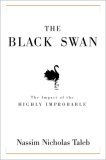Notes on the Black Swan
Just finished reading the book The Black Swan: The Impact of the Highly Improbable. Several important points to take away:
1. A black swan is a random and yet highly improbable, highly impactful event that exists in reality.
2. Black swans are produced in the platonic fold, in which the gap between what you know and what you think you know becomes is dangerously wide. This often happens in areas where the unknown unknowns plays a huge role in the generating process. In such areas the predictive models we construct using known knowns and the margin of error we assume with known unknowns is far far away from reality.
3. Assuming normal (Guassian) distribution in variables subject to black swan would makes predictions that work most of the time. However when the black swan happens, the result is often devastating.
4. There is an information asymmetry between forward and reverse processes. Put an ice cube on your desk, you can predict that in 2 hours you will see water. However, seeing water on your desk, you cannot tell what caused it without other evidences. This asymmetry exists where a cause can have an inevitable effect, but the effect can have many different causes.
5. There are two types of black swans: a. Event that is not expected to happen happens. b. Event that is expected to happen does not happen. Both situations would create huge opportunities or risks to those involved.
Managing the Black Swan
In a way, the value investing concept of Benjamin Graham and Warren Buffet is one way to profit from the postive black swan. When a stock is beat down to very low prices, it basically means that the general expectation of future performances is low. By buying such stock, if the public is right, the downside is little. But if the public is wrong, the upside is huge (a black swan). All the criteria that Graham and Buffet use are to maximize the chance of the black swan happening.
The Kelly Criterion is another way to manage black swans. In fact, it is the optimal solution when dealing with the real world, in which black swans are abundant. If we treat any investment as a rigged black jack game, in which you have X% chance of doubling your money and (1-X%) chance of loosing all your money, the Kelly Criterion would never tell you to commit 100% of your bankroll in the game, no matter how big X is. You can play with the numbers at http://www.cisiova.com/betsizing.asp.
Basically, when black swans happen often, we should exploit its occurances. When black swans are rare, we should benefit from our models, but heed from the black swan with kelly criterion.
